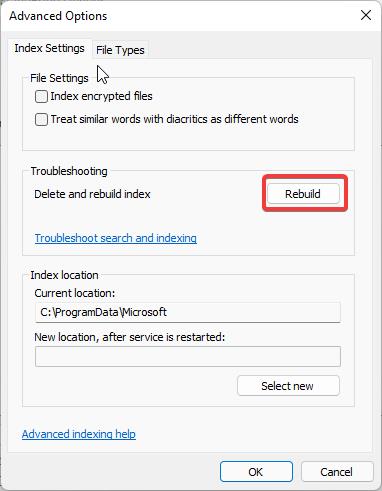

If you have feedback for TechNet Subscriber Support, to all those who responded. Please remember to mark the replies as answers if they helped. After it completed, start search service. Click on Advanced and select the Rebuild Index option.ĥ. But after you delete it, Windows will take a while to re-index the files and rebuild the index, so your searches may be a bit slow till this job is completed.)Ĥ. (Note: It is safe to delete the Windows.edb. Windows.edb file is a hidden file and located in the following folder:Ĭ:\ProgramData\Microsoft\Search\Data\Applications\Windows\Windows.edb visit the Windows.edb file folder and delete it. Double-click on it to open its dialog box. Open Services.msc and navigate to Windows Search service.Ģ. One thread here which mentions that deleting the indexing files and rebuilding the index would help fix this error. Maybe we can send a simple instruction to all users to unselect Outlook manually. There seems to be no option to control Indexing Locations enterprise-wide. Searched a lot but didn't find such a related registry. Removing profiles or re-imaging hundreds of machine, won't do :( Now, back to my question, how do I remove the location? It must be something in the registry. This ensures that earlier Outlook versions can be indexed correctly if Outlook 2010 is uninstalled. The new functionality is built into Outlook 2010, the original Windows Search indexing components and addin are disabled in Outlook 2010, but not removed. Outlook 2010 now includes some of that indexing and search functionality in the program. This handler is responsible for indexing data in earlier versions of Outlook. Windows Desktop Search installs a MAPI Protocol Handler.

#OUTLOOK REBUILD INDEX WINDOWS 10 UPGRADE#
Then, when you upgrade from Office 2010 to Office 365, the application gets uninstalled no problem, but the Search Index location We had caching enabled before going to Office 365. Outlook" was created when you have Office 2010 caching enabled. However, what I found out after tons of research and testing, that this specific location of search index, "Microsoft Office I don't have any other Outlook Profile in my computer. It will not create two Outlook Search Indexing locations, but it will scream for "No default mail client is installed." error. Preventing the creation of a new OST upon upgrade is an option. Outlook Search indexing locations using one OST. It has to be very specific and in the following order 1)Enable caching in Office 2010 2) Verify that Microsoft Office Outlook is now a list in your search indexing location) 3) Upgrade office 2010 to 365 and enable caching 4) Verify that now, you have two

This is probably a bug that needs to be addressed.
#OUTLOOK REBUILD INDEX WINDOWS 10 32 BIT#
We will either go 32 bit or manually having the user disable the invalid location themselves (but this is a pain because we have hundreds of users). Will continue to exist even if you have no more Office installed. It therefore becomes a Windows or Operating System problem more than Office. However, since it is a valid registry key, it completely breaks the function of Outlook being the default mail client.Ĭompletely uninstalling Office 365 or 2010 (using all possible methods) does not remove the locations of the search indexing location of this Outlook. Therefore, if I delete the registry of the default mail client in the HLKM\Software\Clients\Mail, it gets rid of the location in the picture above. The OST is located in C:\Users\name\AppData\Local\Microsoft\Outlook. Both of these Microsoft Office Outlook and Microsoft Outlook points Then, when we upgraded our Office 2010 to 365, it created a new "Microsoft Outlook" location in the search indexing location, but at the same time upgraded the existing OST. However, I was able to find the Registry key, but it did not completely removed & resolved the problem.įor those who have similar issue, to help understand the problem, after many tests and research, I found out that the "Microsoft Office Outlook" was created when we enabled Caching in our Office 2010 environment after we migrated users to the cloud.


 0 kommentar(er)
0 kommentar(er)
